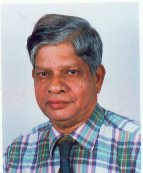Sunday, December 28, 2008
Monday, December 22, 2008
Sunday, December 14, 2008
Sunday, December 07, 2008
Sunday, November 30, 2008
Sunday, November 23, 2008
Wednesday, November 19, 2008
Sunday, October 26, 2008
Tripple loss for Indian Metallurgy
The month of August 2008 was indeed a black month for Indian Metallurgy. Three stalwarts of this field died during this month. Professor D. S. Sarma, teacher and researcher, Dr. Placid Rodriguez and Professor C. V. Sundaram, scientists of the Indian Atomic Energy establishment, leave behind a tremendous legacy of hard work and great achievements. All three of these metallurgists had their initial training at the Indian Institute of Science,
Prof. Sarma spent nearly forty years of his life at the Department of Metallurgical Engineering,
Dr. Rodriguez was a Nuclear Metallurgist of great distinction. Specialized in Mechanical Metallurgy, he contributed immensely to the growth of the nuclear field in
Prof. Sundaram was a pioneer in the field of reactive & refractory metals in
Tuesday, September 23, 2008
Tuesday, August 12, 2008
Sunday, August 03, 2008
Sunday, July 06, 2008
Friday, June 27, 2008
Monday, June 02, 2008
DEVELOPMENTS IN INDIAN METALLURGICAL INDUSTRY
 H’ BLAST FURNACE
H’ BLAST FURNACETata Steel inaugurates India’s largest blast furnace
Tata Steel, the oldest Steel Company in India achieved a milestone on its 100h year of operation when the largest blast furnace in India was blown-in on Saturday, the 31st of May 2008 at its Jamshedpur plant. Mr. R. S. Pandey, the Union Government Steel Secretary, inaugurated the furnace operation. This blast furnace with a volume of 3800 cubic meters and a rating of 2.5 million tonnes per annum will produce over 7,200 tonnes of hot metal a day. The construction of this furnace was undertaken by the engineering firm Larsen & Tubro with technology provided by M/s. Paul Wurth in a short period of 25 months. With the addition of this furnace, the Tata Steel plant at Jamshedpur expects to increase its production capacity to 10 million tonnes by December 2010.
Sterlite acquires Asarco
Sterlite Industries (India), a subsidiary of London-based metal & mining group Vedanta Resources plc signed agreements on 31st May 2008 to buy the assts of Asarco LLC, a Tuscon-based mining, smelting and refining company. The 100 year old Asarco, previously known as the American Smelting & Refining Company, is the third largest copper producer in the U. S. which produced 2.35 lakhs tonnes of refined copper in 2007. The integrated assts of Asarco include three open-pit copper mines with an estimated reserve of 5 million tonnes of contained copper, a copper smelter in Arizona, and a plant at Texas with a copper refinery, rod and cake plant and a precious metals plant. The cost of this acquisition is reported to be 2.6 billion US Dollars.
(Source: The Hindu, June 1, 2008)


